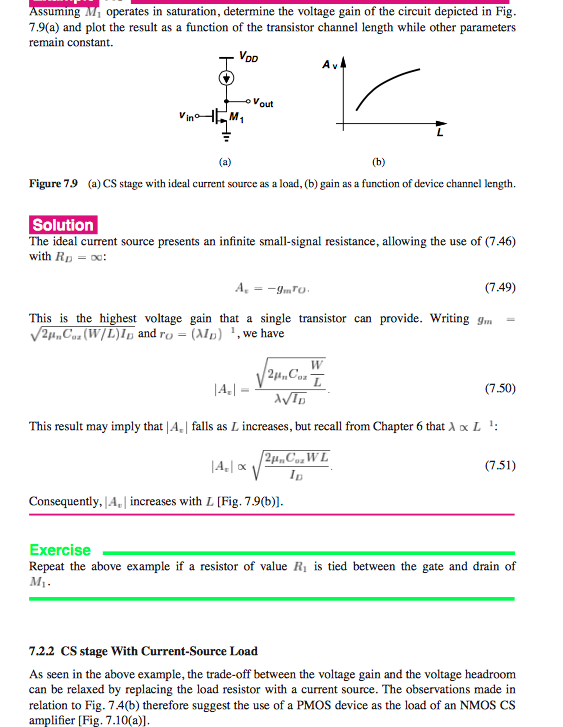My textbook [Fundamentals of Microelectronics: B. Razavi] claims that in order to relax the tradeoff between voltage gain and voltage headroom, we use a current source in place of the load resistor. I don't understand the reasoning behind it, and neither has it been mentioned in the book.
-
\$\begingroup\$ Since headroom implies deviation of tolerance from the optimum midpoint and Av has a square root sensitivity with current, it has a wider % tolerance than a fixed Linear R % tolerance. \$\endgroup\$– D.A.S.Commented Nov 7, 2016 at 18:27
-
\$\begingroup\$ @TonyStewart.EEsince'75 Hey! Can you please explain a little whether what voltage headroom means exactly? I can't find a good answer via google, and the book doesn't define it. My assumption till now was the amplitude of the AC signal that can be used for small signal analysis. \$\endgroup\$– Ekdeep Singh LubanaCommented Nov 7, 2016 at 18:35
-
\$\begingroup\$ headroom is margin to clipping or saturation \$\endgroup\$– D.A.S.Commented Nov 7, 2016 at 18:44
2 Answers
The common source amplifier has a voltage gain of $$A_v = -g_m(R_{\text{L}} \parallel r_o)$$
where \$R_{\text{L}}\$ is the load resistor, and \$r_o\$ is the small signal output resistance of the MOSFET which is generally high (usually \$R_{\text{L}} \ll r_o\$ for reasonable values of \$R_{\text{L}}\$). Increasing \$R_{\text{L}}\$ increases the gain of the circuit.
However, increasing \$R_{\text{L}}\$ also reduces the voltage headroom for the output voltage because of Ohm's Law. The output voltage in terms of \$R_{\text{L}}\$ is
$$v_{\text{out}} = V_{\text{DD}} - i_{\text{D}}R_{\text{L}}$$
However, \$v_{\text{out}}\$ is limited to the range 0V to \$V_{\text{DD}}\$ (the "headroom"). Increasing \$R_{\text{L}}\$ means that \$v_{\text{out}}\$ will hit the 0V rail sooner. You could reduce \$I_{\text{D}}\$ to improve headroom, but that also lowers the gain because \$g_m\$ is proportional to \$I_{\text{D}}\$: $$g_m = \sqrt{2\mu C_{ox}\frac{W}{L}I_{\text{D}}}$$
The only way to increase both headroom and gain with a resistively-loaded common source amplifier is to increase \$V_{\text{DD}}\$, which is usually undesirable and/or not an option.
A current source fixes this problem. An ideal current source has infinite output resistance, which would result in infinite gain for the common source. An ideal current source also supplies a constant current regardless of the voltage across it (it does not obey Ohm's Law). A real current source has finite but high output resistance and isn't entirely independent of the voltage across it, but it nonetheless relaxes this tradeoff between gain and headroom.
-
\$\begingroup\$ actually headroom is a product of both \$i_D, R_L\$ so both contribute equally to saturation or clipping but the gain is also constant with constant current. and as explained before has reduced sensitivity with gain. \$\endgroup\$– D.A.S.Commented Nov 7, 2016 at 19:12
-
\$\begingroup\$ @TonyStewart.EEsince'75 Well, \$i_D\$ is proportional to \$g_m\$ so you lose gain if you reduce \$i_D\$ in order to improve headroom. I've edited my answer to explain that further. \$\endgroup\$– Null ♦Commented Nov 7, 2016 at 19:23
I'll do the analysis for BJTs, but the same principles apply for other transistors.
Consider the situation with a passive load, i.e. Resistor, instead of the current source. The gain is: $$A = \dfrac{R}{r_e}$$ You may be thinking that all you need to do to increase the gain is to increase the resistor. However, that is not the case, provided you keep the Q point the same.
Let the Q point voltage, at the collector, be \$V_Q\$. The quiescent current is then: $$I_Q = \frac{V_{CC} - V_Q}{R}$$ The transconductance can be used here: $$g_m= \frac{1}{r_e} = \frac{I_Q}{V_T} = \frac{V_{CC} - V_Q}{R V_T}$$ The gain then becomes: $$A = \frac{V_{CC} - V_Q}{V_T}$$
So the only way to increase the gain is to move the Q point. If you increase the collector resistance, the emitter resistance increases accordingly. But you can move the Q point only so much, before your output signal starts clipping, or you hit the limits set by the rails. This is what is meant by head room.
Current sources, on the other hand can circumvent that. You can have very high collector resistance, because of the current source, and still have a Q point in the middle of the supply rails. The current source will simply change its voltage to compensate.
With a current source you can achieve gains that exceed what you are able to achieve with passive components. At 5V the theoretical maximum gain you can achieve with just a resistor at room temperature is 200, when you set the Q point at 0V. An actively loaded BJT with a BJT current source can easily achieve a gain of around 2000.

